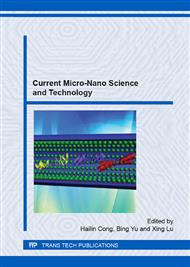[1]
O. O. Adisa, B. J. Cox, J. M. Hill, Methane storage in molecular nanostructures, Nanoscale 4 (2012) 3295-3307.
DOI: 10.1039/c2nr00042c
Google Scholar
[2]
Y. Huang, Q. P. Zheng, N. Fan, K. Aminian, Optimal scheduling for enhanced coal bed methane production through CO2 injection, Appl. Energ. 113 (2014) 1475-1483.
DOI: 10.1016/j.apenergy.2013.08.074
Google Scholar
[3]
M. S. Shafeeyan, W. M. A. W. Daud, A. Houshmand, A. Shamiri, A review on surface modification of activated carbon for carbon dioxide adsorption, J. Anal. Appl. Pyrol. 89 (2010) 143-151.
DOI: 10.1016/j.jaap.2010.07.006
Google Scholar
[4]
J. Schell, N. Casas, R. Pini, M. Mazzotti, Pure and binary adsorption of CO2, H2, and N2 on activated carbon, Adsorption 18 (2011) 49-65.
DOI: 10.1007/s10450-011-9382-y
Google Scholar
[5]
Y. Feng, C. Jiang, D. Liu, W. Chu, Experimental investigations on microstructure and adsorption property of heat-treated coal chars, J. Anal. Appl. Pyrol. 104 (2013) 559-566.
DOI: 10.1016/j.jaap.2013.05.013
Google Scholar
[6]
D. P. Bezerra, R. S. Oliveira, R. S. Vieira, C. L. Cavalcante, D. C. S. Azevedo, Adsorption of CO2 on nitrogen-enriched activated carbon and zeolite 13X, Adsorption 17 (2011) 235-246.
DOI: 10.1007/s10450-011-9320-z
Google Scholar
[7]
S. Park, H. J. Song, J. Park, Selection of suitable aqueous potassium amino acid salts: CH4 recovery in coal bed methane via CO2 removal, Fuel Process. Technol. 120 (2014) 48-53.
DOI: 10.1016/j.fuproc.2013.12.006
Google Scholar
[8]
J. Silvestre-Albero, A. Wahby, A. Sepúlveda-Escribano, M. Martínez-Escandell, K. Kaneko, F. Rodríguez-Reinoso, Ultrahigh CO2 adsorption capacity on carbon molecular sieves at room temperature, Chem. Commun. 47 (2011) 6840-6842.
DOI: 10.1039/c1cc11618e
Google Scholar
[9]
M. Delavar, A. Asghar Ghoreyshi, M. Jahanshahi, S. Khalili, N. Nabian, Equilibria and kinetics of natural gas adsorption on multi-walled carbon nanotube material, RSC Adv. 2 (2012) 4490.
DOI: 10.1039/c2ra01095j
Google Scholar
[10]
G. Srinivas, J. Burress, T. Yildirim, Graphene oxide derived carbons (GODCs): synthesis and gas adsorption properties, Energ. Environ. Sci. 5 (2012) 6453-6459.
DOI: 10.1039/c2ee21100a
Google Scholar
[11]
D. P. Vargas, L. Giraldo, J. Silvestre-Albero, J. C. Moreno-Piraján, CO2 adsorption on binderless activated carbon monoliths, Adsorption 17 (2010) 497-504.
DOI: 10.1007/s10450-010-9309-z
Google Scholar
[12]
J. P. Marco-Lozar, M. Kunowsky, F. Suárez-García, J. D. Carruthers, A. Linares-Solano, Activated carbon monoliths for gas storage at room temperature, Energ. Environ. Sci. 5 (2012) 9833-9842.
DOI: 10.1039/c2ee22769j
Google Scholar
[13]
F. Khaddour, A. Knorst-Fouran, F. Plantier, M. M. Piñeiro, B. Mendiboure, C. Miqueu, A fully consistent experimental and molecular simulation study of methane adsorption on activated carbon, Adsorption 20 (2014) 649-656.
DOI: 10.1007/s10450-014-9611-2
Google Scholar
[14]
M. G. Plaza, A. S. González, C. Pevida, F. Rubiera, Influence of water vapor on CO2 adsorption using a biomass-based carbon, Ind. Eng. Chem. Res. (2014).
DOI: 10.1021/ie500342q
Google Scholar
[15]
Y. Feng, W. Yang, N. Wang, W. Chu, D. Liu, Effect of nitrogen-containing groups on methane adsorption behaviors of carbon spheres, J. Anal. Appl. Pyrol. 107 (2014) 204-210.
DOI: 10.1016/j.jaap.2014.02.021
Google Scholar
[16]
M. S. Shafeeyan, W. M. A. W. Daud, A. Houshmand, A. Arami-Niya, Ammonia modification of activated carbon to enhance carbon dioxide adsorption: Effect of pre-oxidation, Appl. Surf. Sci. 257 (2011) 3936-3942.
DOI: 10.1016/j.apsusc.2010.11.127
Google Scholar
[17]
J. Silvestre-Albero, A. Silvestre-Albero, F. Rodríguez-Reinoso, M. Thommes, Physical characterization of activated carbons with narrow microporosity by nitrogen (77. 4 K), carbon dioxide (273 K) and argon (87. 3 K) adsorption in combination with immersion calorimetry, Carbon 50 (2012).
DOI: 10.1016/j.carbon.2011.09.005
Google Scholar
[18]
K. Vasanth Kumar, F. Rodríguez-Reinoso, Effect of pore structure on the selectivity of carbon materials for the separation of CO2/H2 mixtures: new insights from molecular simulation, RSC Adv. 2 (2012) 9671-9678.
DOI: 10.1039/c2ra20775c
Google Scholar
[19]
P. N. K. De Silva, P. G. Ranjith, Understanding the significance of in situ coal properties for CO2 sequestration: An experimental and numerical study, Int. J. Energ. Res. 38 (2014) 60-69.
DOI: 10.1002/er.3062
Google Scholar
[20]
J. Jiang, Y. Cheng, Effects of igneous intrusion on microporosity and gas adsorption capacity of coals in the Haizi mine, China, The Scientific World J. 2014 (2014) 1-12.
DOI: 10.1155/2014/976582
Google Scholar
[21]
J. Wang, S. Kaskel, KOH activation of carbon-based materials for energy storage, J. Mater. Chem. 22 (2012) 23710-23725.
DOI: 10.1039/c2jm34066f
Google Scholar
[22]
J. R. Morris, C. I. Contescu, M. F. Chisholm, V. R. Cooper, J. Guo, L. He, Y. Ihm, E. Mamontov, Y. B. Melnichenko, R. J. Olsen, S. J. Pennycook, M. B. Stone, H. Zhang, N. C. Gallego, Modern approaches to studying gas adsorption in nanoporous carbons, J. Mater. Chem. A 1 (2013).
DOI: 10.1039/c3ta10701a
Google Scholar
[23]
J. Wang, S. Kaskel, KOH activation of carbon-based materials for energy storage, J. Mater. Chem. 22 (2012) 23710-23725.
DOI: 10.1039/c2jm34066f
Google Scholar
[24]
S. Q. Xu, Z. J. Zhou, G. S. Yu, F. C. Wang, Effects of pyrolysis on the pore structure of four chinese coals, Energ. Fuel. 24 (2010) 1114-1123.
DOI: 10.1021/ef901008a
Google Scholar
[25]
Y. Yao, D. Liu, D. Tang, S. Tang, W. Huang, Fractal characterization of adsorption-pores of coals from North China: An investigation on CH4 adsorption capacity of coals, Int. J. Coal Geol. 73 (2008) 27-42.
DOI: 10.1016/j.coal.2007.07.003
Google Scholar
[26]
W. Yang, Y. Feng, W. Chu, Catalytic chemical vapor deposition of methane to carbon nanotubes: Copper promoted effect of Ni/MgO catalysts, J. Nanotech. 2014 (2014).
DOI: 10.1155/2014/547030
Google Scholar
[27]
Y. Feng, W. Yang, W. Chu, Contribution of ash content related to methane adsorption behaviors of bituminous coals, Int. J. Chem. Eng. 2014 (2014).
DOI: 10.1155/2014/956543
Google Scholar


